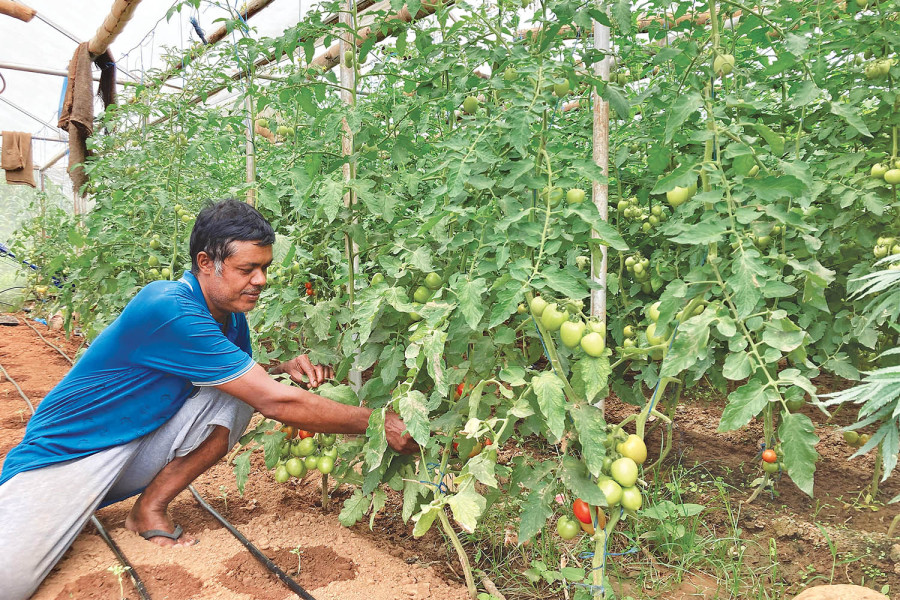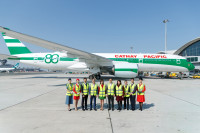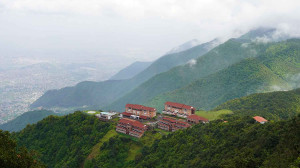Money
Tomato prices jump fourfold in Kathmandu Valley
The price has reached Rs200 per kg in retail. Poor condition of the highways connecting the Valley has affected the supply chain.
Post Report
Tomato prices have soared nearly fourfold within a month in the Kathmandu valley, largely due to a short supply after hectares of farmland were swamped by the devastating floods in September.
According to the Kalimati Fruits and Vegetable Market Development Board, the wholesale price of local tomato (small) jumped 392.61 percent to Rs110 per kg and local tomato produced in tunnels increased by 287 percent to Rs120 per kg from mid-September prices.
Similarly, tomato big (Indian) jumped 107.69 percent to Rs135 per kg.
There is a huge difference between the wholesale and retail prices in the market.
In retail, tomatoes sell between Rs200 and Rs205 per kg.
BhatBhateni Supermarket is selling tomatoes at Rs198 per kg.
Within a year, the wholesale price of tomatoes has sharply risen threefold, according to the wholesale price index of Kalimati market, Nepal’s largest vegetable market.
“Tomato prices have risen steadily after the flood and landslide of September 27. As most of the tunnel farms got hit by floods, market-ready goods were affected, causing a short supply in Kathmandu Valley,” said Binay Shrestha, information officer of the Kalimati Fruits and Vegetable Market Development Board.
Traders said that the supply chain also was broken by the floods and landslides as most of the highways connecting the Valley remained blocked for weeks.
The Tarai region, key producer of foods and vegetables, was also inundated by floods, causing damage to seasonal vegetables, including tomatoes.
The government is yet to assess the loss.
On September 27, the record rainfall in 54 years inundated most of the warehouses of essential food items in the Capital, traders said. The fruits and vegetable market in Balkhu was flooded, while the Kalimati market was partially affected.
According to the preliminary report on loss and damage by the National Disaster Risk Reduction and Management Authority, 4,765 hectares of fruits and vegetable farms were damaged by the late monsoon rains that poured heavily for three days, causing death and destruction across the country from September 26.
According to preliminary reports from the Ministry of Agriculture and Livestock Development, the agriculture and livestock sector has reported losses exceeding Rs6 billion.
But officials say that the loss figure may double.
The new production has not arrived yet. The roads are still in bad condition, preventing cargo from entering the Kathmandu valley on a large scale.
Tomatoes are arriving in the Kalimati fruits and vegetable market from tunnel farming inside the Valley and from neighbouring districts, said Shrestha.
Tomatoes have not arrived from outer districts.
The price might go down once tomatoes start arriving from the Tarai, said Shrestha.
“It may take a month for tomatoes to arrive from the Tarai, if the roads are repaired. But prices have fewer chances to decline as Tihar and Chhath are coming and prices go up due to the high festive demand.”
On a normal day, the Kalimati fruits and vegetable market receives 50–60 tonnes of tomatoes, said Shrestha. But after the floods and landslides, shipment has nosedived.
On Saturday, the Kalimati market received only 30 tonnes of tomatoes. As a result, prices have increased sharply, said Shrestha.
The Kalimati fruits and vegetable market has been receiving less quantity of tomatoes from India because of the road conditions, said Shrestha.
On Saturday, the market received 12 tonnes of Indian big tomatoes.
Prices have increased in India too, traders said.
In India, tomato prices rocketed to IRs100–120 per kg in several markets in early October due to unseasonal rains and a virus attack that damaged the tomato crop in key farming areas around Nashik.
The price gradually started cooling down from the past week to IRs60 per kg, according to Indian media reports.
The rise in the price of the major kitchen staple worries consumers as the price of other green vegetables is already high amid festivities.
According to Nepal Rastra Bank, the year-on-year consumer price inflation stood at 3.85 percent in mid-September this year compared to 8.19 percent a year ago.
Food and beverage inflation stood at 5.03 percent whereas non-food and service inflation stood at 3.19 percent in the review month.
Vegetable inflation increased by 9.84 percent in the review period.




 13.05°C Kathmandu
13.05°C Kathmandu














